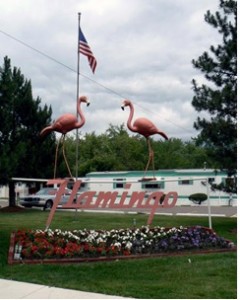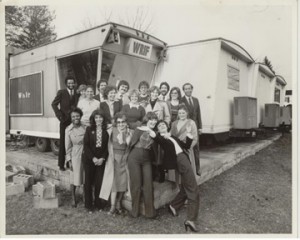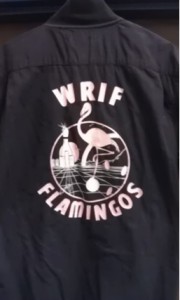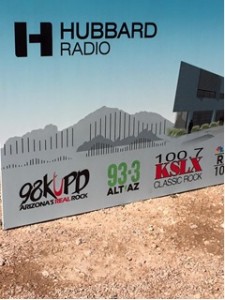Recently, my good friend and former research cohort, Jon Coleman, brought some sad news to my attention. During a very busy news cycle,  you may have missed the story that the inventor of the plastic lawn pink flamingo, Don Featherstone, passed away in Fitchburg, Massachusetts. It turns out Featherstone was a classically trained painter and sculptor who gained fame from those kitschy pink lawn ornamental birds.
you may have missed the story that the inventor of the plastic lawn pink flamingo, Don Featherstone, passed away in Fitchburg, Massachusetts. It turns out Featherstone was a classically trained painter and sculptor who gained fame from those kitschy pink lawn ornamental birds.
What does this have to do with radio? (Go with me here.) There’s a trailer park here in suburban Detroit called the Flamingo Motor Home Court that used Featherstone’s pop culture icons as its symbol. The place is famous here in the area, and for WRIF back in the ‘70s, it became a great source of humor, irony, and sarcasm.
That’s because back in its first incarnation, WRIF’s “world headquarters” was actually comprised of three house trailers and a mobile trailer (known as the production studio), all attached to a tiny wood frame house on (then owner) ABC’s compound that included Channel 7 and WXYZ-AM Radio.
While the station achieved a great deal of success in the ‘70s under legendary PDs that included Lee Abrams, Larry Berger, Roger Skolnik, and a nice long run from Tom Bender, few knew just how ramshackle the physical facility truly was.
Walking through the control room on precisely the wrong spots caused the tone arm on either turntable to skip right through the record on the air. And on the days when the lawn was being mowed, there was no hiding the noise from listeners.
And so one day, pink plastic flamingoes started adoring the lawn, a left-handed salute to that local trailer park. They became a running joke during those days, and a source of counter-culture pride that a station in a very humble environment could become one of the most successful in what was then the sixth largest market in the country.
But it was home, it was rustic, and it helped to create true camaraderie among the staff. The picture at left from 1979 shows many of the staffers, including Bender, Paul Jacobs, Mark Biviano, and a few others who are still making a living in radio today.
You can see true happiness on their faces because WRIF in the early years was especially a fun place to work. The staff hung out together, pounded beers at nearby bars, played softball in the radio/advertising league, and became quite close personally and professionally. Three decades before social media, this was a very social group (as were many radio stations back in those days). 
And yes, the station bowling team became known as (wait for it) the WRIF Flamingos, complete with themed shirts that proudly sported the elegant pink bird that came to symbolize the weird nature of the place.
One year later, WRIF would move into a palatial facility on the other side of the complex. It was a 180° shift from the trailers, with multiple on-air and production studios, a lot of glass, and an atrium cathedral-like conference room fit for serious business meetings, befitting one of the top-rated stations in Detroit.
It was beautiful, spacious, and state of the art…and the entire staff had to work hard to adapt to the new surroundings. Retaining that “pink flamingo magic” was a challenge.
Many stations struggle with their building identity today. As I walk through many buildings that house multiple radio brands during the course of a year, they physically differ considerably. Some are antiseptic, resembling insurance companies or banks. Others have gone with the more open start-up motif, creating work spaces where people can hang out. And then there are the rare stations where the air studio is front and center – a showplace on display that clearly illustrates what the place is about.
As broadcasters continue to transition and morph a traditional medium into one that has adapted to the new standard of the new millennium, the aesthetic in the building can make a huge difference. Tech companies know that environment is everything, especially to the twentysomethings who roam the halls.
Radio has always had that opportunity to present itself as a fun, exciting medium and a great place to work. Times, of course, have changed, and the workplace vibe has grown in importance during these past several years.
 I was thinking about this a couple months back when I visited KUPD/Phoenix for the first time. The station is located in the heart of a seedy residential neighborhood. The building itself is dated, cluttered, musty – and it’s a magical place.
I was thinking about this a couple months back when I visited KUPD/Phoenix for the first time. The station is located in the heart of a seedy residential neighborhood. The building itself is dated, cluttered, musty – and it’s a magical place.
The staff – most of whom have been with the station for years – is a close, tight-knit group, working out of a facility that lacks a modern feel, but more than makes up for it with a true rock n’ roll attitude.
Under its former ownership, the three stations in the group, KUPD along with KSLX and KDKB (ALT AZ) were all working out of different buildings, scattered around the Phoenix area.
So new owner Hubbard Radio is doing the right thing and is building a brand new building that will bring the three stations together, all under the same roof.
It will be a huge upgrade for these staffs to work out of a beautiful, modern building. But for KUPD, in particular, it may be a challenge for station management and staffers to maintain the essence and spirit of the station. Knowing that staff, they will find a way to make a luxurious new building their own.
They might even try putting a pink flamingo or two on the lawn.
- What To Do If Your Radio Station Goes Through A Midlife Crisis - April 25, 2025
- A 2020 Lesson?It Could All Be Gone In A Flash - April 24, 2025
- How AI Can Give Radio Personalities More…PERSONALITY - April 23, 2025




Fred, I love today’s blog. It goes to show that regardless of the conditions, great radio can STILL be done!
It’s also reminiscent of my start in radio.
After interning with Howard Stern at WRNW, he suggested I reach out to a small Rockland county NY radio station, WGRC, where a college buddy of his was program director. It, too, was a couple of trailers parked in a lot in Nanuet/Spring Valley NY.
Sure there was no running water…but we had fun! And once you peel away the trailer shaking when the ‘fat guy’ walked down the hall…and the nearby lawnmowers…it was still radio. There were promos being cut, reel-to-reel tapes being cued up, and Al Ham’s directions followed to a “T”.
The true downside? Well, that was the weekly visit by the Port-o-San man. He needed help getting the hose into the trailer. You never saw MORE people SCATTER than when he came to make a ‘withdrawal’.
True, Fred. All true.
Clearly, time covers over some of the gnarly sides of working out of a hovel. But I share your enthusiasm for great success out of humble surroundings. Thanks, JC.
I was an intern when RIF moved to the beautiful new facility and I fell in love with radio. I still have a trailor hitch memento that was given out at to staff and clients in my office. It was a great place to learn and have a blast for many! BABY!
I forgot about that trailer hitch, Mark. It was a great symbol of where the station came from and why it was important to retain that spirit. Thanks for reminding me, and reading our blog.
In the early 1980s, the transmitter and studios for KIKX/Tucson were in a small building…with a bomb shelter under it, because it was the EBS primary station for the area. The offices were in a double-wide mobile home next to the studio building.
Later in the 1980s, I worked mornings in Benson (Arizona) at KAVV…which was in a single-wide trailer. The control room was in the master bedroom (and I was only a few steps away from the restroom in it). Commercials were on consumer quality audio cassettes…music was on consumer quality reel-to-reel machines.
After, I worked at WYCB in Washington (DC). Which, in the control room, had two turntables…and I don’t remember there being more than two cart machines. I was always difficult to get the owner to keep styluses in stock.
Sometimes, I was forced to be more creative because I was using the worst equipment…
Slick, there is that upside. You can do amazing things with the basics as millions are learning in the digital age. Thanks for the comment.
Loved being a riff intern!!!! That station knew their audience and made listening a relationship and an experience !
And many have gone on to bigger and better things. Thanks, Chris.
Pretty sure the WRIF softball team was still called The Flamingos when I was there…
Or was it the bowling team?
Probably both. Once a flamingo…
Great story Fred, I remember the trailer days. Ever see the 33rd floor of the David Stott Bldg. Same story line!
Al, I was up there a couple times as a fledgling radio guy who would have killed to do some work with ABX. Thanks for the comment.
I could make hundreds of smart ass comments aside about WRIF
I won’t
Thanks for a wonderful chapter of history
You were there, Marty. A great legacy and you saw inside the “sausage factory.” Thanks for the comment.